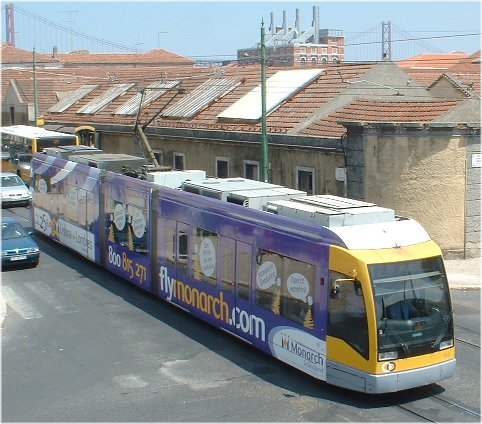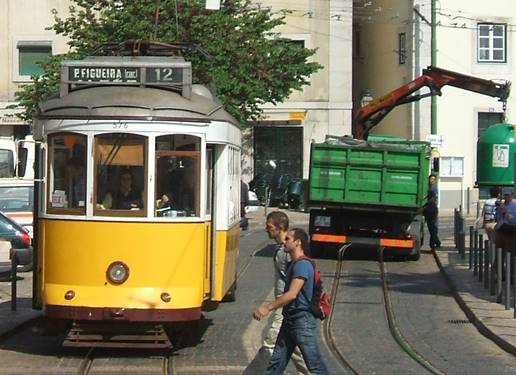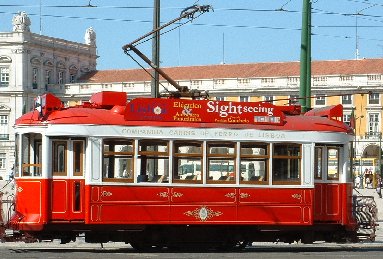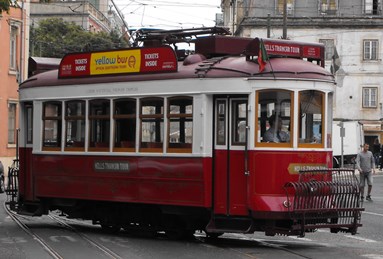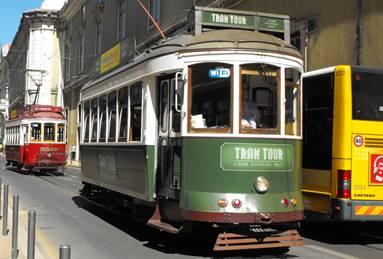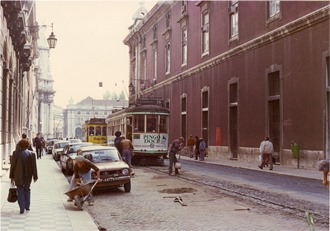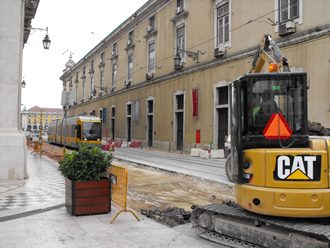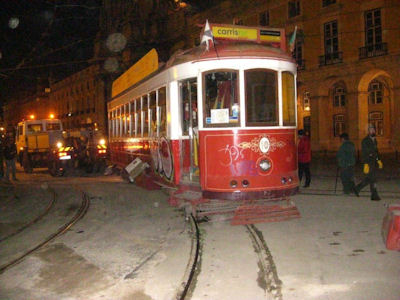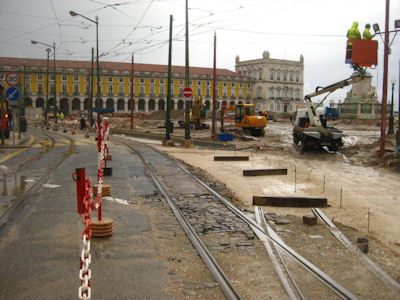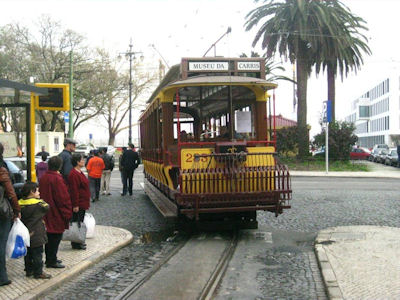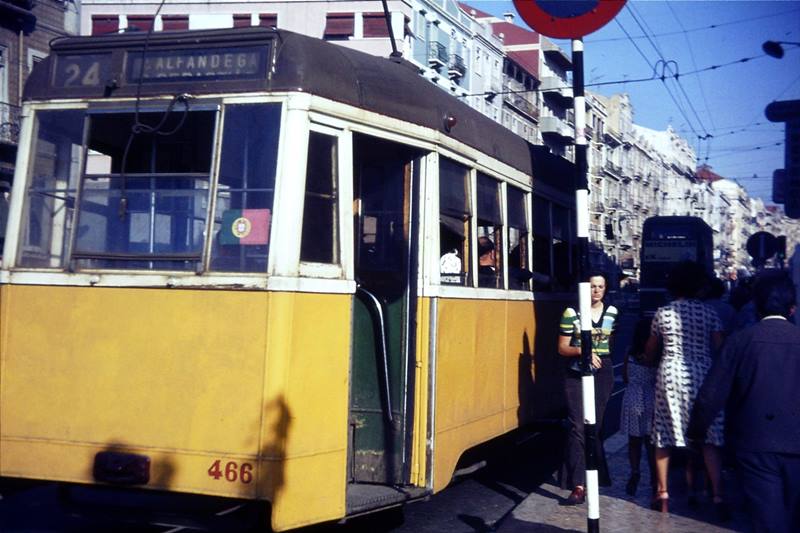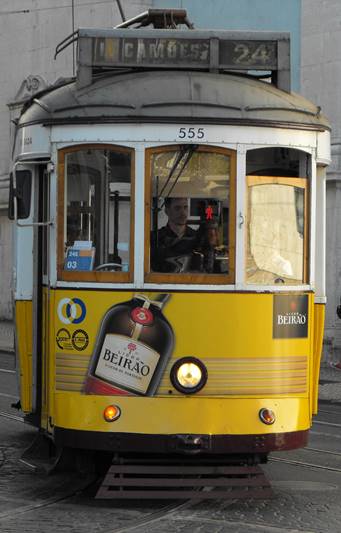Lisbon Trams
The Lisbon Trams webpage has two parts.
Part One: Lisbon Trams of Today
Part Two: Lisbon Trams of the Past
Above left: "A good reason to take the tram" is the slogan for Tagus beer displayed on this Siemens tram, pictured at Praça da Figueira in 2003. Above, centre: Siemens articulated tram, no.505 at Belém, June, 2005. Above right, tram 576 pictured at Portas do Sol, Alfama in 2007. This "remodelado" tram was destroyed in a "runaway" accident whilst operating in the Lapa district on route 25 on 14 December 2018.
Lisbon Trams of Today
Current Fleet
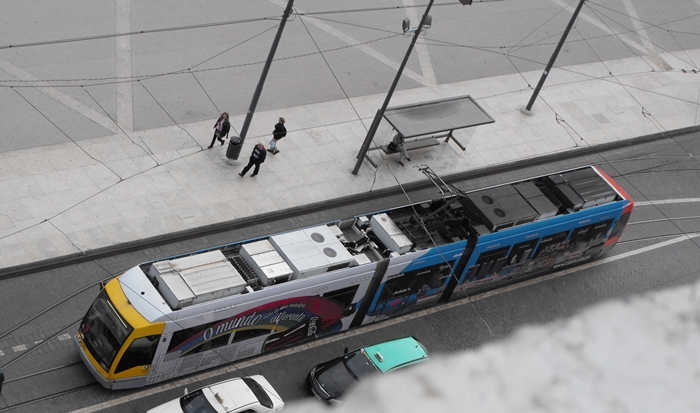
Above: Since its opening in 2012 an unusual vantage point for watching tram (and river) activity around the Praça do Comércio has been fom the top of the historic arch over the Rua Augusta, which can be accessed for €3 (2019). Here we see one of the Siemens trams on route 15 (October 2013).
The diversity of Lisbon's tram fleet has declined markedly in recent years, with the withdrawal in the 1990s of various types, including the characterful 1906 Brill bogie cars, and the abandonment of the use of trailers. Further withdrawals took place as recently as November, 2011. (See Part Two of this page for details of the historic tram fleet). Nevertheless, there is still plenty to see, with the fleet now effectively limited to the ten new (1995+) Siemens articulated trams and a fleet of 45 four-wheelers, known as the 'remodelados'. There is also a significant fleet of tourist trams and museum cars.
In late 1999 some retired 700 class trams had to return to service on route 28, as the 'remodelados' were suffering from a spate of compressor failures. In 2009 Carris listed the available 700 series trams as nine in total, numbered (720-713-717-732-733-735-741-742-744) and built between 1936 and 1947. However, in November 2011, all class 700s were withdrawn as an economy measure, apart from 722 and 745 which continued to operate as "Christmas trams".
Tram 720 is reserved for the museum and so is not used currently whilst in 2009, tram 742 was out of service.
Operational Fleet
All service trams are operated by Carris, (Companhia Carris de Ferro de Lisboa), founded in 1872. Formerly, the articulated trams all carried all-over advertising which, in most cases, also covered the windows. Whilst passengers could see out through the advertising, awaiting passengers found it difficult to see whether the tram was crowded or not, or indeed where the doors were. But, by 2005, increasing numbers of the remodelados trams had been restored to the traditional yellow and white livery, without advertising on the exterior. However, by 2019, unadorned articulated trams were a rarity once more.
Fleet numbers 501-510 These comprise ten three-section trams built by Siemens and used exclusively on the coastal route #15 to Algés from Praça da Figueira. They entered public service in April, 1995. These trams are air-conditioned and hold 210 passengers, including those standing. Their overall length is 24.02 metres and they have 65 seats. They have two 105kw motors and can reach 70km/hr. All are single-ended, with four sets of 'plug-type' sliding doors and interior digital indicators indicating each tram-stop.
Fleet numbers 541-585
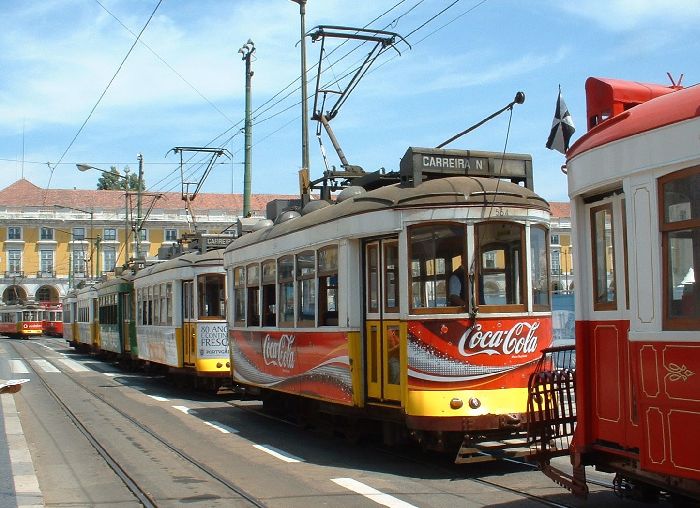
These are the new numbers for 45 remodelled trams drawn from 221-282 series and from 701-724, but also including 415 and 483. (See Part Two of the Lisbon Trams page for details). The remodelados were introduced in July 1995 but are actually all older Standard cars from the 1930s, rather than the more modern lightweight vehicles of the 736 series. They were chosen for remodelling as the Standards were of stronger original construction and had not generally been worn-out by use on the more hilly routes. Nowadays, they have two Skoda motors and have been generally upgraded to give a smoother journey, whilst retaining traditional tourist appeal. They have only 20 seats but space for 38 standing. All are unidirectional and have both trolley poles (for the narrower streets) and pantographs fitted. Their size is 8.382m by 2.378m.
Above: Remodelados queue up in Praça do Comércio in summer 2005, awaiting an influx of tourists on an organised tour from a visiting cruise ship. Note the fitting of trolley poles as well as pantographs to each vehicle. Trolley poles are needed for the more restricted and steeper routes.
Tourist Trams
Left to right: Lisbon tourist tram in smart livery, as seen in 2002; centre, Lisbon tourist tram or "Historical Premium Tramcar", no.8, as seen in 2016; right, Green tourist tram, as seen in 2019. .
When first introduced as tourist trams, these "hisoric" cars were initially turned out in an attractive red, white and gold-livery, fitted with Providence lifeguards which operated the tourist routes. These routes started with what is now marketed as the 'Circuito das Colinas' ('Hilly-route Circular') which passes through the steep and tortuous streets of the Alfama district from the Praça do Comércio, via Martim Moniz, to Estrela and back. The tour-trams' interiors have been retro-converted to an approximation of early 20th-century fittings. One of these vehicles is seen in the accompanying photograph, in the Estrela turning loop. This journey can be duplicated by normal service vehicles on routes 28 and 25 for much less outlay but with the tourist trams you are guaranteed a seat and get a commentary. Also, service tram 28, in particular, is often very crowded.
The eight operating tourist trams are nos. 3 to 9 and 11, which were formerley service vehicles numbered 726, 723, 583, 585*, 584, 546, 570 and 569 respectively. Also, there was even a bogie tram (#10, formerly no.355) in the "tourist" livery which spent a few years parked in the Praça do Comércio as a booking office. Preserved tourist trams no. 1 and 2 were formerly #435 and 437 respectively. *585 was previously 719.
Sadly the tourist trams, (now run as part of the "Carristur" operation), since at least 2016, have been repainted in either a bogus livery of cardinal red or bottle green. Those in red were re-badged in English as "Lisbon Historical Premium Tramcars" in what appears to be an appeal to the anglophone tourist market. Serices run from Praça do Comércio, via Praça da Figueira, Martim Moniz, Graça, Portas do Sol, Sé, Conceição, Camões, Estrela and back to Praça do Comércio and the journey takes approx. 90 minutes at a cost of 20 euros for adults, half-price for children (2019).
An alternative (summer months only) is the green-liveried "Castle Tramcar Tour" which runs from Largo Camões to Alfama and last 75 minutes.
Museum Trams
For details of the Carris museum fleet, housed at Santo Amaro, visit the Museum Page.
Track Developments
Tram track repairs are a constant feature of all networks. The images above show repairs/remodelling in the same stretch of the Rua do Arsenal in 1991 (left) and 2016 (right).
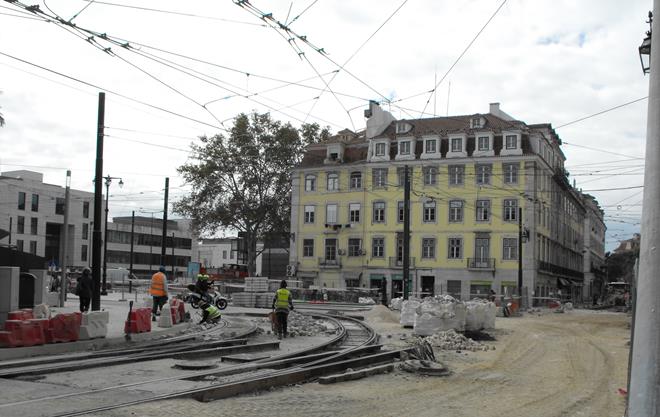 |
In October 2016 work was in progress to complete the diversion of tram tracks from their previous route between Praça Comércio and Cais do Sodré. Trams on route 15 were already by this time using a new section of track which branches off the Rua do Arsenal, left, at Corpo Santo (as shown above) to join the Avenida da Ribeira. The track then runs along the front of Cais do Sodre station's historical frontage to join up with the pre-existing track along Avenida 24 de Julho.
In the image (left), Cais do Sodre lies behind the yellow building. The point of the work appeared to be to simplify the outbound route which formerly crawled around the busy Praca Duque de Terceira. It is effectively a reinstatement of an old alignment as the 1947 map below shows. In addition to the new section of track, the entire line back almost to the Praça do Comercio was renewed in 2016. .
Route 25 continued to terminate at Corpo Santo until at least 2016 but by 2019 was continuing to a terminus at Praça Figueira.
|
Some earlier track works are shown below...
|
Right: David Gourlay's picture taken on 7 April 2010 clearly shows the new layout at P. Comércio at that time.
In 2010 track relaying took place in Comercio and in February 2012 David Gourlay indicated that work had started that day in Praça do Comércio "to realign the tram line running from Praça da Figueira/Rua Alfandega (westwards) towards Cais do Sodré. The line is going to be moved closer to the buildings on the north side of the square, with bus lanes being placed between the tram lines". This has now been completed.
David subsequently posted the following videos on You Tube which show the scene before and after the works were completed.
Friday 30th March 2012 from tram 566 on the last day of service over the old line in Praça do Comércio.
Saturday 31st March 2012 from tram 504 on the first day of service over the new line in Praça do Comércio.
Zorra 395 leaving Santo Amaro with the track.
Zorra 395 in Rua do Arsenal
|
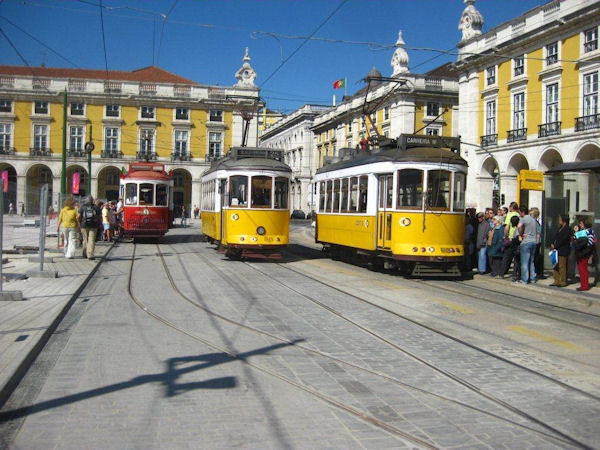 |
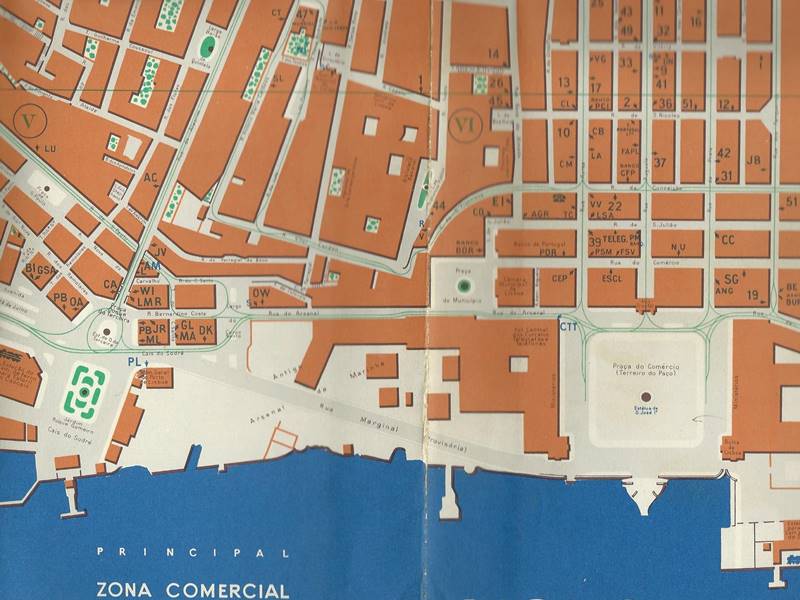
| Left is an enlargeable map showing the tram track layout around Praça Comércio and Cais do Sodré c.1947.
Below: Courtesy of David Gourlay are these pictures from March/April 2010 of the track works affecting the P. do Comércio. David writes: "A new loop is currently under construction at the western end of Praça do Comércio. The whole square has been a building site for the last year but the race is on to finish it before the Pope's visit in May. The west sidings have been completely removed and the east ones shortened, though they're still in use. The track with Tourist Tram 10 is now completely isolated and the neighbouring connected siding is long enough for one tram only (and isused by all tourist trams). The idea of the loop is to remove the need for the tourist trams to reverse. In high season this caused a lot of problems if a tram coming back from the tour arrived before the next one was due out, as it would then be blocking the line". Tram 10 is shown (far left) being moved to its new location.
Also pictured below, right, by David Gourlay, is museum tram 283 which in March made a photo stop at Corpo Santo on the curve normally used by route 25, which may have made it the first bogie tram to go there since the route 19 (to Alcantara Terra) closed in April, 1991. Pictured left is Tourist Tram 10 being moved to its new location.
|
Current Routes
Lisbon's tram network map has seen large cuts over the last 25 years. Having been reduced to five routes for many years, from 2018 it has six remaining services, which are all operated by the Carris company. The sixth route was a restoration, on 24 April 2018 after almost 22 years of closure, of part of the route 24. This shortened route runs from from Praça Camões (near the Chiado exit of the Metro station of Baixa-Chiado) to Campolide. The six surviving routes are, therefore:
- 12: This is the shortest route on the system and is a circular route from Praça da Figueira via Martim Moniz to the hilly Alfama district. This includes one of the steepest sections in the city, at S.Tomé. Formerly route 12 operated an even shorter, non-circcular route, wholly within the Alfama. Services operate approximately four times an hour though, at times, only one car is used and timings can be erratic. Heavy loadings are frequent.
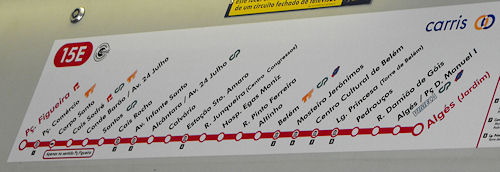
15: Praça Figueira to Algés (Jardim), which is a distance of about 10km. The terminus moved temporarily from Praça Figueira to Alfândega in 2009 due to works in Praça do Comércio but has since reverted to Praça Figueira.
This route has the fastest section on the network as it runs along reserved tram track from outside Cais do Sodré railway station to Alcântara-Mar, where it moves inland, before regaining sight of the coast near Belém. With the coast on your left, on the right-hand side there are good views of the Jerónimos monastery at Belém. The tram serves the Museu dos Coches (get off at Belém centre), the Mosteiro dos Jerónimos (alight at the stop so named) and the Museu Naval (get off at the Centro Cultural de Belém stop). At the Centro Cultural, the route is slightly inland from the sea but, soon afterwards, on the left can be glimpsed the manueline Torre de Belém and the site of the defunct station at Pedrouços.
Before it reaches Belém the tram also stops at the Carris tram depot at Santo Amaro where the Carris museum is located.
Beyond Belém, at Algés, but shortly before the terminus there is a major bus station and a train station on the line to Estoril and Cascais, the latter being accessible via a subway from the bus station. Shortly beyond the bus station, the tram terminates at a turning loop in Algés Jardim (Algés Garden), which is a short walk (straight on) from the interesting aquarium at Dafundo, which lies a little further to the west where the tram route 15 use to have a terminus but which it no longer serves.
Formerly the route extended even further to the west, beyond Dafundo to Cruz Quebrada, with a branch from there to the national football stadium (Jamor), where Glasgow Celtic famously won the European Cup. In the June 2018 issue of Today's Railways Europe magazine, it states that there are plans to re-open the 15 line beyond Algés to its old terminus at Cruz Quebrada.
The 15 route is the only service operated by the 1995 Siemens articulated trams which have capacity for 210 passengers. It has a useful interchange at Cais do Sodré with the rail services on the Cascais Line, with city buses and with river ferries.
As well as being operated by the Siemens articulated trams, route 15 is supplemented by services operated by smaller "remodelados" trams and also by buses bearing route number 15E. The E letter stands for elétrico (formerly spelt eléctrico), the Portuguese word for a tram. Back in 2002, the 15 route was being half-heartedly marketed as the Linha dos Museus (Museums' Line) as it runs reasonably close to 18 museums between the Aquarium at Dafundo (Algés) and the Museu das Comunicações, near Cais do Sodré. Some short-workings to Belém operate and these turn in a loop just short of the Jerónimos monastery and these were formerly designated as route 15A. Into the 1990s the trams on route 15 often ran with trailers but this is no longer the case.
All other Lisbon tram routes nowadays are operated by the smaller "remodelados" trams.
18: This route has undergone many changes in recent years. For many years it ran from central Lisbon to Ajuda cemetery, north west of the city, until 3 March 2012, when it was cut back to run from Cais do Sodré, to the west of the city centre. The latter part of this route from Santo Amaro to the Ajuda cemetery was very steep but because tourists had not colonised it, was mostly frequented by locals.
By 2019 route 18 was advertised as running a much shorter route from the Mosteiro dos Jeronimos at Belém to Ajuda i.e instead of linking Ajuda, eastward to the city centre via Santo Amaro, it was continuing in a westerly direction to Belém once it reached Santo Amaro.
Before that (c.2018) the original route to Ajuda cemetery had been cut back drastically at its western end so that it no longer ran to the cemetery but, instead, took a new right-hand turn along a short, new section of track to the Ajuda royal palace where a new terminus was created.
Also, as of early summer 2019 there was further disruption because of roadworks near the Ajuda Palace; at that point the 18 was advertised as running from Cais do Sodré to Belém, i.e. mirroring the route 15 in that section. The Ajuda terminus was reinstated on 17 June 2019.
Ajuda cemetery is one of three burial grounds which formed historical termini for various Lisbon tram routes. The cemetery terminus at Prazeres is still functioning, on route 25, but the route 17 to the Alto do São João cemetery has long since ceased to operate.
Before its most recent rerouting, route 18 had been reported to be facing complete closure and had also been threatened with curtailment at its former western end at Largo do Calvário (near Santo Amaro tram depot). Indeed, approval existed to construct a new turning loop at Calvário, near Santo Amaro depot, but that was not built. In 2009, the starting point for this route had been moved to P. Figueira from Rua da Alfândega but in 2012 its starting point was Cais do Sodre.
24: Initially it was announced that this defunct route would be reopened in 2006 from Carmo to Campolide but, finally, on 24 April 2018, almost 22 years after its closure in August 1996, the line finally did re-open, albeit from the Praça Camões (near Baixa-Chiado metro station's Chiado exit) to Campolide. Initially, Carris ran a service every fifteen to twenty minutes for most of the day on a 19 minute journey with stops at Largo Trindade Coelho, Ascensor da Glória, Príncipe Real, Rua Escola Politécnica, Rato, Jardim Amoreiras, Rua Amoreiras, Avenida Conselheiro Fernando Sousa, and Campolide.
There is little of interest at the Campoilide turning loop, although there are local bus services from there and a cafe should you wish to linger. Also, the modern Amoreiras shopping centre is not far away.
In the June 2018 issue of Today's Railways Europe magazine, in a piece on the revival of route 24, it said that 30 new Lisbon trams were being ordered "in the medium term", 20 of them articulated, and that some of the current tourist trams are being redeployed onto normal fare-paying routes to give operating capacity to allow the route 24 to be extended to terminate at Cais do Sodré. Such an extension implies a reopening of the steep route on the Rua do Alecrim between Camões and Cais do Sodré.
Above, left, a "caixote" on the old route 24 near Pc do Chile. Middle, a route diagram of the former route. Right, tram 555 arrives at Camões on the new route 24 (2019).
The new terminus at Camões is the nearest practical turning point nowadays to the former starting point at Carmo. As can be seen, the run from Camões to Campolide is only a relatively short part of the old route which was virtually a circular, terminating at Alfândega, just east of the Praça do Comércio. In 2018 work started to reopen the coastal route to Santa Apolónia railway station to serve the new cruise-ship terminal there. It is then planned to extend tram services further up the Tagus estuary, to reach the Parque das Nações/Oriente area, replicating the former route 17 which terminated at Poço do Bispo.
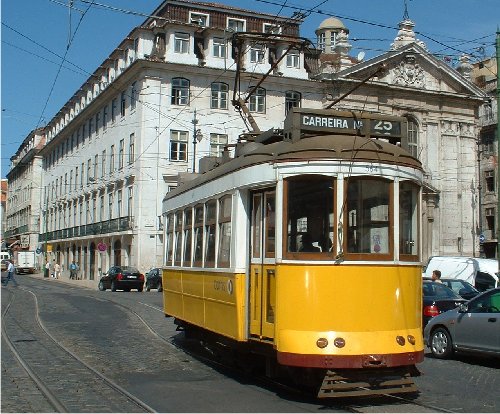
25: This route formerly ran from Rua da Alfândega, via Estrela basilica, to the Prazeres cemetery in western Lisbon. It now starts at Praça Figueira (2019). A 10-15 minute frequency of service is operated. This is an interesting route via the hilly Buenos Aires district, past numerous embassies, an area which is otherwise off the tourist track. Line 25E has no tram service at all on weekday evenings, Saturdays, Sundays and holidays (at the time of writing) and is replaced by a minibus service. It can be easier to get a seat on this route than on the 28 or 15. The Lapa section was scene of a fatal accident in 2018 when a tram ran away downhill after its driver failed to apply its brakes.
This route runs close by the Museu de Arte Antiga, Lisbon's main art museum.
Above: A 25 service at Corpo Santo, July 2003.
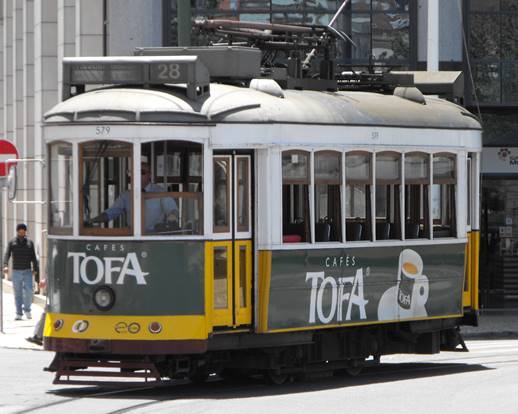
Above: Tram 579 leaves Martim Moniz in 2010.
28: Martim Moniz to Prazeres. This is the classic tram route of Lisbon with extensive hilly and narrow streets in the Alfama district. For this reason it is very heavily used by tourists as well as locals.
Eastbound trams for the Alfama are invariably crowded by the time they reach the Rua da Conceição in central Lisbon, so it can be wise to board in the opposite direction (i.e travelling towards Estrela and Prazeres) and return to the Alfama from that end of the route. After leaving the city centre towards Alfama the route passes the cathedral (Sé) and the viewpoint over the Tagus at Santa Lúzia. It then climbs past the church of São Vicente de Fora up to Graça before descending back towards the city terminus at Martim Moniz. It can also be easier to do the route in reverse by boarding at Martim Moniz.
Westbound towards Estrela and Prazeres, there is a very steep, twisting section up the Calçada de S. Francisco as the route leaves Lisbon centre. This is one of the steepest sections in the network. Services operate about every seven minutes, though short-workings to Estrela at one end and Graça at the other, are included in these timings.
Prazeres cemetery itself is itself an interesting spot and has good views across the Alcântara valley which include the Tagus bridge, the docks and Alcântara-Terra station of Portuguese Railways. The Estrela Park, opposite the Basilica, which is three-quarters of the way to Prazeres, is a pleasant spot,to break the journey, and has a pleasant outdoor cafe.
Use of Trams
Stops
Historically tram stops were suspended from the overhead, and were rectangular, the older ones being white and carrying the word 'Paragem' ('Stop'), whilst the newer ones were yellow and bore the route number. Sometimes this is prefixed by the letter E, (e.g. E15 = 'Elé[c]trico', i.e. tram, 15). Nowadays trams have conventional bus-stop-type poles on the pavement.
Getting On and Off
All trams are one-person operated. In the remodelados, the driver issues tickets, whilst passengers with existing tickets use the validators. On the Siemens articulated vehicles, the driver is in a close compartment; these trams have coin operated ticket machines and also validating machines for pre-bought tickets.
The remodelados should be entered at the front and exited by the rear doors. The articulated trams may be entered or left by any of the four sets of automatic doors. On the articulated trams, the name of each stop is displayed and announced as the tram approaches it and route maps are posted above the doors.
|
 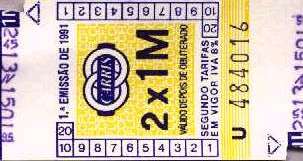 
L to R: A 3$00 ticket (1971); a 1991 ticket; a 1$50 ticket (1971).
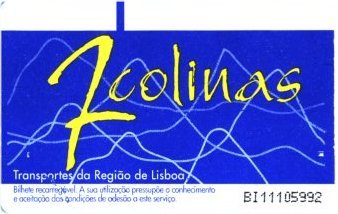
Sete Colinas rechargeable ticket
|
Tickets
Although there is an array of tickets and passes available to users of public transport in Lisbon, for the visitor, things were simplified by the Sete Colinas (7 Hills) proximity pass. (The title is an allusion to the belief that Lisbon is built on 7 hills, like Rome). This replaced the Tourist Pass (bilhete turístico) which could be acquired for either a four or seven-day period. The Sete Colinas pass itself is now largely but not totally supplanted by the Viva Viagem card, which costs half a Euro and can then charged up for a full day to allow unfettered transport on all of the Carris and Metro network (6,40 euros in 2019). Alternatively cash can be loaded onto the card for individual journeys.
For details of ticketing see the Carris & Ticketing page.
All vehicles and Metro turnstiles have card readers. The card need only be held over the sensor (like London's Oyster card) to register and, indeed, can even be left in a plastic wallet when doing this. The blank card (0,50 euros) can be purchased at any Metro station (from machines) and at Carris kiosks. (NB Much more widely publicised to tourists is the Lisboa/Lisbon card, which is much more expensive as its main benefit is to give discount admission to tourist attractions - see below).
Carris tickets bought from bus or tram drivers are charged at the 'Tarifa de bordo' ('On-board tariff') and are relatively expensive per journey.
All tickets should be cancelled on boarding trams and buses, using the on-board machines. On the articulated trams, tickets can be bought with coins only from on-board machines, as the driver does not sell tickets or check passes.
As of 2016 fares were:
Tickets bought on board for a single journey - buses €1,80, trams €2,85, funiculars (up & down return) €3,60, elevator (up & down return) €5,00
Tickets charged onto a Viva Viagem/7 Colinas pass for a single journey - for Carris/Metro €1,40
Tickets charged onto a Viva Viagem/7 Colinas pass for a 24h pass on Carris/Metro €6,00, on Carris/Metro/Transtejo (Cacilhas) €9,00, Carris/Metro/CP € 10,00
VV cards can also be uploaded with cash.
An alternative for tourists who wish to visit Lisbon's museums is the Lisbon Card, which gives unlimited use of Carris services (except the Aerobus, tourist bus and tram-tour route, as well as free use of the Metro and of the Cascais railway line from C. Sodré to Belém. In addition it provides free entry to 26 Lisbon museums and monuments. Amongst the museums covered are the Maritime Museum, Coach Museum and Air Museum. The Card may be purchased in City Tourist Offices and other outlets.
Buying a ticket on the tourist trams is very expensive. As route 28 largely mirrors the tourist tram's "Hilly" route, a Viva Viagem card is a much better bet.
|
Depots
The sole tram depot remaining is at Santo Amaro, between central Lisbon and Belém. Visitors to the Carris museum get a free tram ride within the depot complex as part of the admission price. The Bolaria café across the road affords a good vantage point for watching tram movements at Santo Amaro. This depot has been in existence since before the electric trams arrived in Lisbon in 1901.
Formerly other tram depots existed in Lisbon. One of these was the Arco de Cego depot, built in 1902 on a 29,176sq.m. site acquired in 1882, but this closed in the 1990s. By then it had lost 9,000sq. metres of land to the national mint. Arco do Cego then acquired a new lease of life as Lisbon's main long-distance coach station but this is now decommissioned and the site was converted in 2005 into a leisure facility. For details, see the Lisbon Suburban Bus and Coach page.
A third Carris depot at Amoreiras closed in 1981 and is now the site of a modernistic shopping centre. Carris bus depots operate at Pontinha (opened 1975), Musgueira (1981) and Miraflores (1983).
|
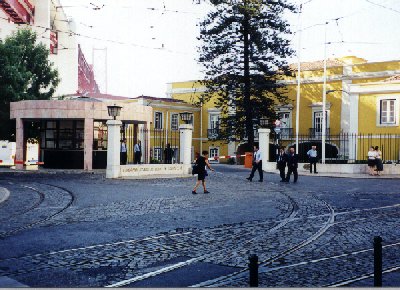
Above: Santo Amaro depot in July, 2000
|
Santo Amaro blog
Part 2 of the Lisbon Trams Page covers:
Lisbon Trams of the Past
Including:
Historic Fleet Details
Tram Trailers and Works Cars
Carris Museum of Transport
Old Tram Routes in Lisbon
Reading Matter: references to books and images relating to Lisbon trams
Links to other related sites
Contact: the following is not a link; please transcribe the address into your email 

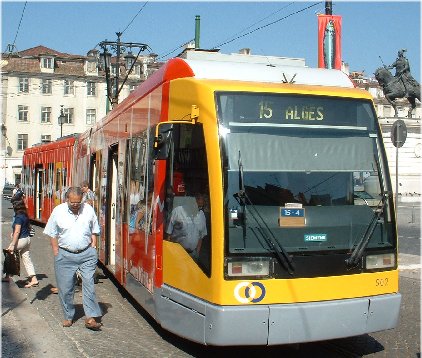
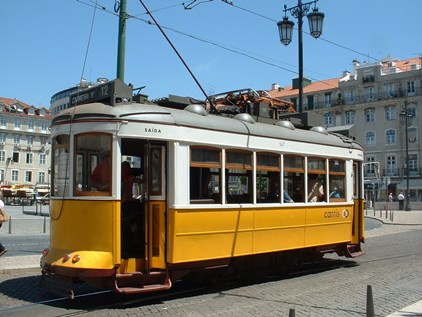

 April 2018 in part
April 2018 in part